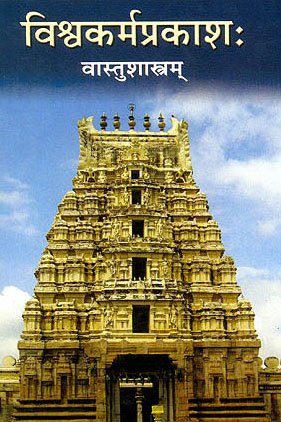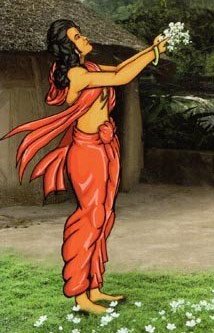Pratoli, Pratolī: 14 definitions
Introduction:
Pratoli means something in Hinduism, Sanskrit, the history of ancient India. If you want to know the exact meaning, history, etymology or English translation of this term then check out the descriptions on this page. Add your comment or reference to a book if you want to contribute to this summary article.
In Hinduism
Vastushastra (architecture)
Source: Shodhganga: Temples of Salem region Up to 1336 ADPratoli (प्रतोलि) is the term used to denote the gateway pavilion.

Vastushastra (वास्तुशास्त्र, vāstuśāstra) refers to the ancient Indian science (shastra) of architecture (vastu), dealing with topics such architecture, sculpture, town-building, fort building and various other constructions. Vastu also deals with the philosophy of the architectural relation with the cosmic universe.
Kavya (poetry)
Source: archive.org: Naisadhacarita of SriharsaPratolī (प्रतोली) refers to 1) a “street” or 2) “antechamber”, “entrance”, and is mentioned in the Naiṣadha-carita 6.58.—Nārāyaṇa take the word [pratolī] in its usual sense of “a street”, but this meaning is hardly applicable here. Damayantī’s Sabhā is described as being located on a bejewelled platform of the Pratolī of the royal palace. Here Pratolī means “antechamber”, “entrance”, “corridor”. Cāṇḍūpaṇḍita says “pratolī praveśamārgaḥ”. Narahari says “dvāravīthī”. The word seem to be used in the above sense in Udayasundarīkathā and in Abhinanda’s Rāmacarita 17.9. The word is used in a similar sense in Śyāmilaka’s Pādatāḍitaka (in caturbhāṇī).
The word [pratolī] is often used in the sense of “a fortified gate or door”, “a gateway”. In this sense Pratolī is practically the same as Gopura. Cāṇḍūpaṇḍita in his gloss on 1.22 and Kṣīrasvāmin on Amara 2.2.16 explain gopura as Pratolī. Śrutasāgāra does the same in his commentary on Yaśastilaka (chapter 4). Cf. Candraprabhacarita 2.129; Tilakamañjarī; Vikramāṅkadevacarita 9.105; Devīpurāṇa 72.139, 140; 93.90; Surathotsava 1.25; Jinamaṇḍana’s Kumārapālaprabandha quoted by Dalal in his introduction to Rūpakaṣaṭka.
The word [pratolī] occurs in its Prākṛta form [padoli?] in Koūhala’s Līlāvaī (verse 732) in connection with the establishment of a royal camp, and seems to mean “a gateway” or “a boundary wall” or “a partition”. In verse 688 paolivāla (pratolīpāla) means “a door-keeper”, “a sentry”. Pratolī occurs in its Prākṛta form also in Mṛcchakaṭika, Act VIII (pāśādabālaggapadolikāe). The reference seems to be to a tower (perhaps gopura) in front of the palace wher ethe Śakāra proposes to imprison the Ceṭa. Cf. Assamese paduli, “the front entrance of a compound”
Source: OpenEdition books: Vividhatīrthakalpaḥ (Kāvya)Pratolī (प्रतोली) in Sanskrit probably means “main road” (usual meaning “portal”), as is mentioned in the Vividhatīrthakalpa by Jinaprabhasūri (13th century A.D.): an ancient text devoted to various Jaina holy places (tīrthas).—(Sircar 1966 p. 261);—(CDIAL 8633; ST p. 27, 77, 167; Sircar 1966 p. 261).

Kavya (काव्य, kavya) refers to Sanskrit poetry, a popular ancient Indian tradition of literature. There have been many Sanskrit poets over the ages, hailing from ancient India and beyond. This topic includes mahakavya, or ‘epic poetry’ and natya, or ‘dramatic poetry’.
India history and geography
Source: Cologne Digital Sanskrit Dictionaries: Indian Epigraphical GlossaryPratolī.—(EI 9; CII 3; BL), a gate-way; a gate-way with a flight of steps; a gate-way strongly built and considerably high. (EI 31), probably, a street. Note: pratolī is defined in the “Indian epigraphical glossary” as it can be found on ancient inscriptions commonly written in Sanskrit, Prakrit or Dravidian languages.

The history of India traces the identification of countries, villages, towns and other regions of India, as well as mythology, zoology, royal dynasties, rulers, tribes, local festivities and traditions and regional languages. Ancient India enjoyed religious freedom and encourages the path of Dharma, a concept common to Buddhism, Hinduism, and Jainism.
Languages of India and abroad
Sanskrit dictionary
Source: DDSA: The practical Sanskrit-English dictionaryPratolī (प्रतोली).—
1) A street, main road, principal street through a town; प्रापत् प्रतोलीमतुलप्रतापः (prāpat pratolīmatulapratāpaḥ) Śiśupālavadha 3.64; सहर्म्यद्वितलां द्व्यर्धा- यामां प्रतोलीं कारयेत् (saharmyadvitalāṃ dvyardhā- yāmāṃ pratolīṃ kārayet) Kau. A.2.3.21. स्वयमभवन् विवृताः पुरप्रतोल्यः (svayamabhavan vivṛtāḥ purapratolyaḥ) Bu. Ch.5.82.; N.6.58.
2) A kind of bandage; Suśr.
Source: Cologne Digital Sanskrit Dictionaries: Shabda-Sagara Sanskrit-English DictionaryPratolī (प्रतोली).—f. (-lī) A high street, the principal road through a town or village. E. pra before, tul to weigh, aff. ac gaurā0 ṅīṣ .
Source: Cologne Digital Sanskrit Dictionaries: Benfey Sanskrit-English DictionaryPratolī (प्रतोली).—f. A high street, [Rāmāyaṇa] 2, 87, 22 Gorr.
Source: Cologne Digital Sanskrit Dictionaries: Cappeller Sanskrit-English DictionaryPratolī (प्रतोली).—[feminine] broad way, high street.
Source: Cologne Digital Sanskrit Dictionaries: Monier-Williams Sanskrit-English Dictionary1) Pratolī (प्रतोली):—[=pra-tolī] f. a broad way, principal road through a town or village (ifc. līka), [Mahābhārata; Kāvya literature] etc.
2) [v.s. ...] a kind of bandage applied to the neck or to the penis, [Suśruta]
Source: Cologne Digital Sanskrit Dictionaries: Yates Sanskrit-English DictionaryPratolī (प्रतोली):—[pra-tolī] (lī) 3. f. A high street.
Source: DDSA: Paia-sadda-mahannavo; a comprehensive Prakrit Hindi dictionary (S)Pratolī (प्रतोली) in the Sanskrit language is related to the Prakrit word: Paolī.
[Sanskrit to German]
Sanskrit, also spelled संस्कृतम् (saṃskṛtam), is an ancient language of India commonly seen as the grandmother of the Indo-European language family (even English!). Closely allied with Prakrit and Pali, Sanskrit is more exhaustive in both grammar and terms and has the most extensive collection of literature in the world, greatly surpassing its sister-languages Greek and Latin.
Kannada-English dictionary
Source: Alar: Kannada-English corpusPratōli (ಪ್ರತೋಲಿ):—
1) [noun] the main or important road in a city.
2) [noun] a place having a raised platform for the leaders or juries of a village.
--- OR ---
Pratōḷi (ಪ್ರತೋಳಿ):—[noun] = ಪ್ರತೋಲಿ [pratoli].
Kannada is a Dravidian language (as opposed to the Indo-European language family) mainly spoken in the southwestern region of India.
See also (Relevant definitions)
Starts with: Pratolidvara, Pratolika, Pratolike, Pratolina.
Ends with: Ganikapratoli, Maha-pratoli, Sampratoli.
Full-text: Sampratoli, Maha-pratoli, Pratolike, Paoli, Pratolika, Dvaramandapa, Kaksha, Toli.
Relevant text
Search found 10 books and stories containing Pratoli, Pra-toli, Pra-tolī, Pratolī, Pratōli, Pratōḷi, Pratolli, Pratōlḷi; (plurals include: Pratolis, tolis, tolīs, Pratolīs, Pratōlis, Pratōḷis, Pratollis, Pratōlḷis). You can also click to the full overview containing English textual excerpts. Below are direct links for the most relevant articles:
Vastu-shastra (4): Palace Architecture (by D. N. Shukla)
Vastu-shastra (1): Canons of Architecture (by D. N. Shukla)
(iv.c) Aparājitapṛcchā (Summary) < [Chapter 5 - Study of Hindu Science of Architecture]
(v,4) Vāstu in Kauṭilya’s Arthaśāstra < [Chapter 4 - An outline History of Hindu Architecture]
(i) Viśvakarmā’s Vastuśāstra (Summary) < [Chapter 5 - Study of Hindu Science of Architecture]
Vastu-shastra (2): Town Planning (by D. N. Shukla)
Amarakoshodghatana of Kshirasvamin (study) (by A. Yamuna Devi)
Town Planning (2): Shop and Market < [Chapter 3 - Social Aspects]
Harshacharita (socio-cultural Study) (by Mrs. Nandita Sarmah)
1. Similarities (5): Economic Condition < [Chapter 8 - Comparative Society as described in the Kādambarī and the Harṣacarita]
4. Economic Condition < [Chapter 6 - Other Socio-Cultural Aspects]
Vastu-shastra (5): Temple Architecture (by D. N. Shukla)
Layanas—Early Mauryan Specimens < [Chapter 12 - History of Hindu Temples (Prāsādas and Vimānas)]